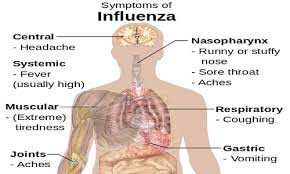Influenza:
Influenza pathogens belong to the family of orthomyxoviruses, the genus Influenzavirus, which includes two types of influenza viruses: A and B.
Influenza viruses contain RNA and an outer shell containing two anigens (hemagglutinin and neuramidinase) that can change their properties, especially in influenza A For the diagnosis of the disease, the method of immunofluorescence (direct and indirect) is used, which makes it possible to detect the influenza virus in the upper respiratory tract or smears from the nose (sensitivity - 58-100%, specificity - 88-100%), as well as detection of NP-ant (the nucleoprotein protein associated with RNA) or the M protein (the main protein of the virus particle) of the influenza virus by the ELISA method (sensitivity is 40-100%, specificity is 52-100%). For the detection of antibodies to influenza viruses, DSC or ELISA is used. When RBC study is carried out at the beginning of the disease (1-2 days) and after 5-7 days, the diagnostic is considered to increase antibody titer no less than 4 times when examining paired sera.
The ELISA method is more sensitive (according to the reports of different authors, from 39% to 100%) and very high specificity. As with RSK, for use in the diagnostic purposes of ELISA, it is necessary to compare the content of antibodies in serum samples obtained from patients at the beginning and at the end of the disease. Determination of the content of antibodies to the influenza A and B virus is used to diagnose acute respiratory viral infections, assess the intensity of postvaccinal immunity, diagnose influenza A and B.
Here are the symptoms for the influenza virus:
Here are the symptoms for the influenza virus:



0 Comments
Post a Comment